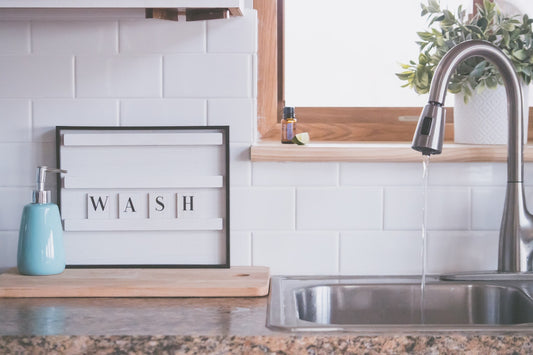Have you noticed a sudden change in the color or smell of your tap water at home and want to make sure it’s safe to drink?
Or perhaps you’re just curious about the quality of your water in general?
Regardless of the reason, know that you’re not alone.
In fact, 91% of Americans consume tap water, and 40% of the population distrusts the water that comes from their tap at home.
After all, water quality is essential to your health, and some contaminants can cause severe illnesses.
Now, fortunately, the number of testing options available has increased over the last few years, allowing homeowners to check the quality of their tap water in a few different ways.
And to assist you, we’ve highlighted below three of the easiest ways to assess your tap water quality so that you know exactly what you’re drinking.
Look for a Water Quality Report in your Town or Area
Water and wastewater companies are strictly regulated by government agencies such as the Department of Environmental Protection and the Environmental Protection Agency. Indeed, stringent regulations have been implemented to ensure the safety of public water systems.
Therefore, community water suppliers must regularly test the water supply quality and make the results available to the public. And these results are compiled every year in a Water Quality Report.
These Annual Water Quality Reports cover critical information such as:
- The source of the drinking water
- The risks of contamination of the local drinking source
- The regulated contaminants found in the drinking water
You’ll find more information about the kind of information these reports encompass here.
Where to access Water Quality Reports?
- Contact your local water supplier and request detailed information regarding contaminants in your tap water and where the water comes from. Make sure to request a copy of their Annual Drinking Water Quality Report (also called Consumer Confidence Report).
- You should normally receive the Annual Drinking Water Quality Report from your water supplier each year by July 1st. However, if for some reason you don’t, you can also access your report by browsing the National Drinking Water Database.
- Contact your local municipality or visit the website of your city and type; Water Quality Report in the search bar to populate the latest report. Here’s an example of the latest Water Quality Report for the city of Cincinnati.
Request a State-certified Laboratory Test
Unfortunately, the options mentioned above don’t apply if you’re on a private well.
Approximately 10% of people in the United States rely on private wells for their drinking water. Yet, private wells are not regulated under the EPA (Environmental Protection Agency).
As a result, if you use a private well, you’re responsible for ensuring your drinking water is safe. And you can do so by requesting a private test from a state-certified laboratory.
Note that regularly testing your private well's water quality is critical as it will allow you to ensure a safe and reliable water source free from harmful contaminants. And it will also help you identify and address any potential problems.
As a result, you should have your well water tested at least once a year. When you proceed to the test, make sure to sample your water both at the tap and the source.
Some of the main things you should test for include:
- Coliform bacteria
- Nitrates
- pH
- Sodium
- Chloride
- Fluoride
- Sulfate
- Iron
- Hardness
- Manganese
- Total dissolved solids
- Extra tests: depending on the situation, you might need to require additional testing for other contaminants such as arsenic, selenium, uranium, or pesticide.
Where can I get my well water tested?
The first step is to get in touch with your county health departments. They might be able to help you test for bacteria or nitrates.
Alternatively, you’ll be able to find a list of state-certified laboratories by calling the Safe Drinking Water Hotline at 800-426-4791. You can also visit the EPA’s website and refine your search by state here.
How much will it cost?
The cost will vary a lot depending on the number of tests that you’re requesting. Indeed, according to the Centers for Disease Control and Prevention, your water test can cost you anywhere between $15 and up to a few hundred dollars.
Use a Home Drinking Water Testing Kit
From test strips, color disks, and chemical titration tests to photometers and TDS handheld water quality testers, home water tests come in various types.
These tests will allow you to check for a wide range of water contaminants such as:
-
Iron
- Coliform bacteria
- Lead
- Pesticides
- Chlorine
- pH
-
Hardness
- Total dissolved solids
- Nitrates/nitrites
- Arsenic
Now, the most common home water testing kits are test strips. Indeed, these inexpensive kits are usually great for measuring bacteria, lead, pesticides, nitrites/nitrates, chlorine, hardness, and drinking water pH levels.
The idea is to dip these small, single-use strips in the water. They’ll then change color, indicating the concentration of a specific chemical.
Depending on the brand or manufacturer, each test will work a little bit differently. So, make sure to carefully read the instructions before dipping the strips in the water.
However, generally speaking, once the strip has been exposed to the water, you’ll usually have to wait for 5 seconds to see it change color. You can then compare the color to the chart provided with the testing kit to assess the level of each substance you’re testing for.
Where Can I Get a Home Drinking Water Testing Kit?
You can find inexpensive kits online on websites such as Amazon. As a word of advice, always make sure to thoroughly read the indications regarding the type of substances the test kit you’re about to purchase allows you to test for.
We hope this article has provided you with some valuable insights regarding testing your drinking water quality. Even though the US has one of the safest drinking water supplies on the planet, over 7 million people contract waterborne diseases every year. Therefore, it’s important to make sure your tap water is safe to drink. By following the simple steps highlighted above, you’ll be able to protect your health and that of your family.






